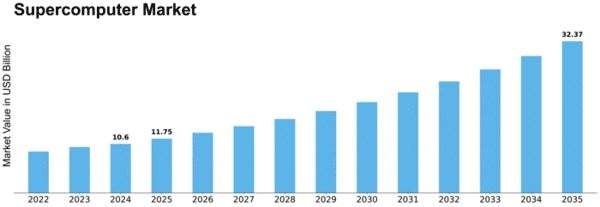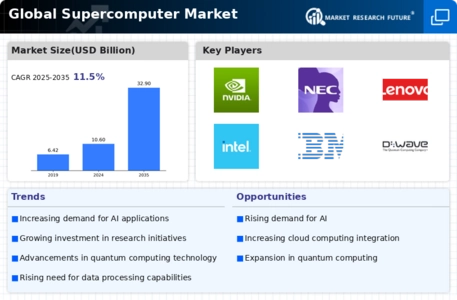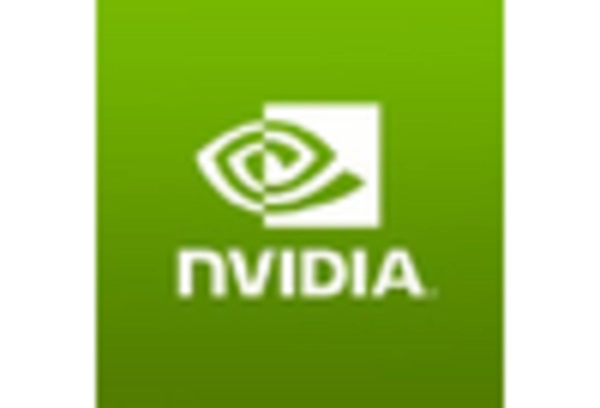-
EXECUTIVE SUMMARY
-
MARKET INTRODUCTION
-
Definition
-
Scope of the Study
- Research Objective
- Limitations
-
Assumptions
-
RESEARCH METHODOLOGY
-
Overview
-
Data Mining
-
Secondary Research
-
Primary Research
- Breakdown of Primary
-
Primary Interviews and Information Gathering Process
-
Respondents
-
Forecasting Model
-
Market Size Estimation
- Top-Down Approach
-
Bottom-Up Approach
-
Data Triangulation
-
Validation
-
MARKET DYNAMICS
-
Overview
-
Drivers
-
Restraints
-
Opportunities
-
MARKET FACTOR ANALYSIS
-
Value Chain Analysis
-
Porter’s Five Forces Analysis
- Bargaining
- Bargaining Power of Buyers
- Threat of
- Threat of Substitutes
- Intensity of Rivalry
-
Power of Suppliers
-
New Entrants
-
COVID-19 Impact Analysis
- Market Impact Analysis
- Opportunity and Threat Analysis
-
Regional Impact
-
GLOBAL SUPERCOMPUTER
-
MARKET, BY TYPE
-
Overview
-
Vector Processing Machines
-
Tightly Connected Cluster Computer
-
Commodity Cluster
-
GLOBAL SUPERCOMPUTER
-
MARKET, BY END USER
-
Overview
-
Commercial Industries
-
Government Entities
-
Research Institutions
-
GLOBAL SUPERCOMPUTER
-
MARKET, BY APPLICATION
-
Overview
-
Cloud Infrastructure
-
Commercial
-
Space & Research Centers
-
Hospitals & Laboratories
-
Government Entities
-
Defense
-
BFSI
-
GLOBAL SUPERCOMPUTER
-
MARKET, BY REGION
-
Overview
-
North America
- US
-
Canada
-
Europe
- Germany
- France
- UK
- Italy
- Spain
- Rest of Europe
-
Asia-Pacific
- China
- India
- Japan
- South Korea
- Rest of Asia-Pacific
-
Australia
-
Rest of the World
- Africa
- Latin America
-
Middle East
-
COMPETITIVE LANDSCAPE
-
Overview
-
Competitive Analysis
-
Market Share Analysis
-
Major Growth Strategy in the Global Supercomputer Market,
-
Competitive
-
Benchmarking
-
Leading Players in Terms of Number of Developments in the
-
Global Supercomputer Market,
-
Key developments and Growth Strategies
- New Product Launch/Service Deployment
- Merger & Acquisitions
- Joint Ventures
-
Major Players Financial Matrix
- Major Players R&D Expenditure.
-
Sales & Operating Income, 2022
-
COMPANY PROFILES
-
NVIDIA
- Company Overview
- Financial Overview
- Products Offered
- Key Developments
- SWOT Analysis
- Key Strategies
-
NEC Corporation
- Company Overview
- Financial Overview
- Products
- Key Developments
- SWOT Analysis
- Key
-
Offered
-
Strategies
-
Lenovo
- Company Overview
- Financial
- Products Offered
- Key Developments
- Key Strategies
-
Overview
-
SWOT Analysis
-
Intel
- Company
- Financial Overview
- Products Offered
- SWOT Analysis
- Key Strategies
- Company Overview
- Financial Overview
- Products
- Key Developments
- SWOT Analysis
- Key
-
Overview
-
Key Developments
-
IBM
-
Offered
-
Strategies
-
FUJITSU
- Company Overview
- Financial
- Products Offered
- Key Developments
- Key Strategies
-
Overview
-
SWOT Analysis
-
Dwave
- Company
- Financial Overview
- Products Offered
- SWOT Analysis
- Key Strategies
- Company Overview
- Financial Overview
- Key Developments
- SWOT Analysis
-
Overview
-
Key Developments
-
Honeywell
-
Products Offered
-
Key Strategies
-
SpaceX
- Company Overview
- Financial
- Products Offered
- Key Developments
- Key Strategies
-
Overview
-
SWOT Analysis
-
Dell
- Company
- Financial Overview
- Products Offered
- SWOT Analysis
- Key Strategies
-
Overview
-
Key Developments
-
APPENDIX
-
References
-
Related Reports
-
LIST
-
OF TABLES
-
GLOBAL SUPERCOMPUTER MARKET, SYNOPSIS, 2018-2032
-
TABLE
-
GLOBAL SUPERCOMPUTER MARKET, ESTIMATES & FORECAST, 2018-2032 (USD BILLION)
-
GLOBAL SUPERCOMPUTER MARKET, BY TYPE, 2018-2032 (USD BILLION)
-
TABLE
-
GLOBAL SUPERCOMPUTER MARKET, BY END USER, 2018-2032 (USD BILLION)
-
TABLE 5
-
GLOBAL SUPERCOMPUTER MARKET, BY APPLICATION, 2018-2032 (USD BILLION)
-
TABLE
-
NORTH AMERICA: SUPERCOMPUTER MARKET, BY TYPE, 2018-2032 (USD BILLION)
-
TABLE
-
NORTH AMERICA: SUPERCOMPUTER MARKET, BY END USER, 2018-2032 (USD BILLION)
-
NORTH AMERICA: SUPERCOMPUTER MARKET, BY APPLICATION, 2018-2032 (USD BILLION)
-
US: SUPERCOMPUTER MARKET, BY TYPE, 2018-2032 (USD BILLION)
-
TABLE
-
US: SUPERCOMPUTER MARKET, BY END USER, 2018-2032 (USD BILLION)
-
TABLE 11
-
US: SUPERCOMPUTER MARKET, BY APPLICATION, 2018-2032 (USD BILLION)
-
TABLE 12
-
CANADA: SUPERCOMPUTER MARKET, BY TYPE, 2018-2032 (USD BILLION)
-
CANADA:
-
SUPERCOMPUTER MARKET, BY END USER, 2018-2032 (USD BILLION)
-
CANADA:
-
SUPERCOMPUTER MARKET, BY APPLICATION, 2018-2032 (USD BILLION)
-
EUROPE:
-
SUPERCOMPUTER MARKET, BY TYPE, 2018-2032 (USD BILLION)
-
EUROPE: SUPERCOMPUTER
-
MARKET, BY END USER, 2018-2032 (USD BILLION)
-
EUROPE: SUPERCOMPUTER
-
MARKET, BY APPLICATION, 2018-2032 (USD BILLION)
-
GERMANY: SUPERCOMPUTER
-
MARKET, BY TYPE, 2018-2032 (USD BILLION)
-
GERMANY: SUPERCOMPUTER MARKET,
-
BY END USER, 2018-2032 (USD BILLION)
-
GERMANY: SUPERCOMPUTER MARKET,
-
BY APPLICATION, 2018-2032 (USD BILLION)
-
FRANCE: SUPERCOMPUTER MARKET,
-
BY TYPE, 2018-2032 (USD BILLION)
-
FRANCE: SUPERCOMPUTER MARKET, BY END
-
USER, 2018-2032 (USD BILLION)
-
FRANCE: SUPERCOMPUTER MARKET, BY APPLICATION,
-
ITALY: SUPERCOMPUTER MARKET, BY TYPE, 2018-2032
-
(USD BILLION)
-
ITALY: SUPERCOMPUTER MARKET, BY END USER, 2018-2032
-
(USD BILLION)
-
ITALY: SUPERCOMPUTER MARKET, BY APPLICATION, 2018-2032
-
(USD BILLION)
-
SPAIN: SUPERCOMPUTER MARKET, BY TYPE, 2018-2032 (USD
-
BILLION)
-
SPAIN: SUPERCOMPUTER MARKET, BY END USER, 2018-2032 (USD
-
BILLION)
-
SPAIN: SUPERCOMPUTER MARKET, BY APPLICATION, 2018-2032 (USD
-
BILLION)
-
UK: SUPERCOMPUTER MARKET, BY TYPE, 2018-2032 (USD BILLION)
-
UK: SUPERCOMPUTER MARKET, BY END USER, 2018-2032 (USD BILLION)
-
TABLE
-
UK: SUPERCOMPUTER MARKET, BY APPLICATION, 2018-2032 (USD BILLION)
-
TABLE
-
REST OF EUROPE: SUPERCOMPUTER MARKET, BY TYPE, 2018-2032 (USD BILLION)
-
TABLE
-
REST OF EUROPE: SUPERCOMPUTER MARKET, BY END USER, 2018-2032 (USD BILLION)
-
REST OF EUROPE: SUPERCOMPUTER MARKET, BY APPLICATION, 2018-2032 (USD
-
BILLION)
-
ASIA-PACIFIC: SUPERCOMPUTER MARKET, BY TYPE, 2018-2032 (USD
-
BILLION)
-
ASIA-PACIFIC: SUPERCOMPUTER MARKET, BY END USER, 2018-2032
-
(USD BILLION)
-
ASIA-PACIFIC: SUPERCOMPUTER MARKET, BY APPLICATION,
-
JAPAN: SUPERCOMPUTER MARKET, BY TYPE, 2018-2032
-
(USD BILLION)
-
JAPAN: SUPERCOMPUTER MARKET, BY END USER, 2018-2032
-
(USD BILLION)
-
JAPAN: SUPERCOMPUTER MARKET, BY APPLICATION, 2018-2032
-
(USD BILLION)
-
CHINA: SUPERCOMPUTER MARKET, BY TYPE, 2018-2032 (USD
-
BILLION)
-
CHINA: SUPERCOMPUTER MARKET, BY END USER, 2018-2032 (USD
-
BILLION)
-
CHINA: SUPERCOMPUTER MARKET, BY APPLICATION, 2018-2032 (USD
-
BILLION)
-
INDIA: SUPERCOMPUTER MARKET, BY TYPE, 2018-2032 (USD BILLION)
-
INDIA: SUPERCOMPUTER MARKET, BY END USER, 2018-2032 (USD BILLION)
-
INDIA: SUPERCOMPUTER MARKET, BY APPLICATION, 2018-2032 (USD BILLION)
-
AUSTRALIA: SUPERCOMPUTER MARKET, BY TYPE, 2018-2032 (USD BILLION)
-
AUSTRALIA: SUPERCOMPUTER MARKET, BY END USER, 2018-2032 (USD BILLION)
-
AUSTRALIA: SUPERCOMPUTER MARKET, BY APPLICATION, 2018-2032 (USD BILLION)
-
SOUTH KOREA: SUPERCOMPUTER MARKET, BY TYPE, 2018-2032 (USD BILLION)
-
SOUTH KOREA: SUPERCOMPUTER MARKET, BY END USER, 2018-2032 (USD BILLION)
-
SOUTH KOREA: SUPERCOMPUTER MARKET, BY APPLICATION, 2018-2032 (USD BILLION)
-
REST OF ASIA-PACIFIC: SUPERCOMPUTER MARKET, BY TYPE, 2018-2032 (USD BILLION)
-
REST OF ASIA-PACIFIC: SUPERCOMPUTER MARKET, BY END USER, 2018-2032
-
(USD BILLION)
-
REST OF ASIA-PACIFIC: SUPERCOMPUTER MARKET, BY APPLICATION,
-
REST OF THE WORLD: SUPERCOMPUTER MARKET,
-
BY TYPE, 2018-2032 (USD BILLION)
-
REST OF THE WORLD: SUPERCOMPUTER
-
MARKET, BY END USER, 2018-2032 (USD BILLION)
-
REST OF THE WORLD: SUPERCOMPUTER
-
MARKET, BY APPLICATION, 2018-2032 (USD BILLION)
-
MIDDLE EAST: SUPERCOMPUTER
-
MARKET, BY TYPE, 2018-2032 (USD BILLION)
-
MIDDLE EAST: SUPERCOMPUTER
-
MARKET, BY END USER, 2018-2032 (USD BILLION)
-
MIDDLE EAST: SUPERCOMPUTER
-
MARKET, BY APPLICATION, 2018-2032 (USD BILLION)
-
AFRICA: SUPERCOMPUTER
-
MARKET, BY TYPE, 2018-2032 (USD BILLION)
-
AFRICA: SUPERCOMPUTER MARKET,
-
BY END USER, 2018-2032 (USD BILLION)
-
AFRICA: SUPERCOMPUTER MARKET,
-
BY APPLICATION, 2018-2032 (USD BILLION)
-
LATIN AMERICA: SUPERCOMPUTER
-
MARKET, BY TYPE, 2018-2032 (USD BILLION)
-
LATIN AMERICA: SUPERCOMPUTER
-
MARKET, BY END USER, 2018-2032 (USD BILLION)
-
LATIN AMERICA: SUPERCOMPUTER
-
MARKET, BY APPLICATION, 2018-2032 (USD BILLION)
-
LIST OF FIGURES
-
RESEARCH PROCESS
-
MARKET STRUCTURE FOR THE GLOBAL SUPERCOMPUTER
-
MARKET
-
MARKET DYNAMICS FOR THE GLOBAL SUPERCOMPUTER MARKET
-
FIGURE
-
GLOBAL SUPERCOMPUTER MARKET, SHARE (%), BY TYPE, 2022
-
GLOBAL SUPERCOMPUTER
-
MARKET, SHARE (%), BY END USER, 2022
-
GLOBAL SUPERCOMPUTER MARKET,
-
SHARE (%), BY APPLICATION, 2022
-
GLOBAL SUPERCOMPUTER MARKET, SHARE
-
(%), BY REGION, 2022
-
NORTH AMERICA: SUPERCOMPUTER MARKET, SHARE (%),
-
BY REGION, 2022
-
EUROPE: SUPERCOMPUTER MARKET, SHARE (%), BY REGION,
-
ASIA-PACIFIC: SUPERCOMPUTER MARKET, SHARE (%), BY REGION, 2022
-
REST OF THE WORLD: SUPERCOMPUTER MARKET, SHARE (%), BY REGION, 2022
-
GLOBAL SUPERCOMPUTER MARKET: COMPANY SHARE ANALYSIS, 2022 (%)
-
NVIDIA: FINANCIAL OVERVIEW SNAPSHOT
-
NVIDIA: SWOT ANALYSIS
-
NEC CORPORATION: FINANCIAL OVERVIEW SNAPSHOT
-
NEC
-
CORPORATION: SWOT ANALYSIS
-
LENOVO: FINANCIAL OVERVIEW SNAPSHOT
-
LENOVO: SWOT ANALYSIS
-
INTEL: FINANCIAL OVERVIEW SNAPSHOT
-
INTEL: SWOT ANALYSIS
-
IBM.: FINANCIAL OVERVIEW SNAPSHOT
-
IBM.: SWOT ANALYSIS
-
FUJITSU: FINANCIAL OVERVIEW SNAPSHOT
-
FUJITSU: SWOT ANALYSIS
-
DWAVE: FINANCIAL OVERVIEW SNAPSHOT
-
DWAVE: SWOT ANALYSIS
-
HONEYWELL: FINANCIAL OVERVIEW
-
SNAPSHOT
-
HONEYWELL: SWOT ANALYSIS
-
SPACEX: FINANCIAL
-
OVERVIEW SNAPSHOT
-
SPACEX: SWOT ANALYSIS
-
DELL: FINANCIAL
-
OVERVIEW SNAPSHOT
-
DELL: SWOT ANALYSIS

















Leave a Comment